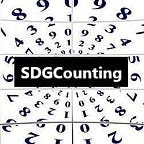SDGCounting — An Introduction
The Sustainable Development Goals have been approved by the United Nations.
There are 17 top goals, 169 targets, a still-to-be-determined number of sub-targets, metrics, etc.
Tens of thousands of organizations, millions of individuals, every country of the world, all the NGOs, UN agencies, funders, social enterprises, corporations, religious groups, etc. etc. will be doing work to contribute to reaching toward the #global goals #sdgs. And every single one of them will be counting — establishing and measuring outputs, outcomes, budgets, expenses, ROI, etc. etc.
@SDGCounting is a new initiative designed to try to understand all the ways that ‘counting’ is being done and to try to come up with and / or share ideas for how to make the counting easier and less redundant. We absolutely believe in measurement but we also believe that it can get out of control and become burdensome, especially for the people on the ground who are providing services.
We’ll be trying to find resources, share ideas and point out places where there’s unnecessary overlap.
To get started, we’ve put together a short curated guide. Please let us know how we can be helpful.
Four resources to get you started
The SDGs are a set of global goals which aim to end poverty, protect the planet and ensure prosperity for all. The 17 goals, each with their own sets of targets to be achieved over 15 years, build on the work started through the Millennium Development Goals. Here are a few of the core articles to get you started.
Sustainable Development Goals: All You Need To Know — The Guardian provides a FAQ to get you started.
Post-2015 Sustainable Agenda — An overview of, and brief video on, the SDGs, straight from the United Nations Development Programme (UNDP).
What are the SDGs about? — An easily digested infographic with the 17 goals and some helpful content.
Sustainable Development Goals: Changing the World in 17 Steps — Again, The Guardian provides a detailed, interactive look at the 17 goals, including how they relate to the MDGs.
The SDGs: How we got here
In many ways, the SDGs are an extension of the work that began with the Millennium Development Goals (MDGs). The MDGs were the first global, time-bound targets aimed at addressing issues surrounding poverty and basic human rights. Here are three resources to help you understand the MDGs, how countries are performing and the transition from MDGs to SDGs.
The Millennium Development Goals: What they are — The Millennium Project, commissioned by the UN Secretary General, provide an overview and listing of the 8 MDGs.
Millennium Development Goals: 2014 Progress Chart — This chart, compiled by Statistics Division, Department of Economic and Social Affairs, United Nations, is a visual depiction of progress on selected targets, segmented by geography, related to each MDG.
Moving from Millennium Development Goals to Sustainable Development Goals — The GHR Foundation highlights some key differences between the SDGs and MDGs.
What gets measured gets done
Self-described “social ecologist” Peter Drucker is often attributed with saying “what gets measured gets done.” It makes sense — if the SDGs are to end poverty, protect the planet and ensure prosperity for all, they will need methods to measure progress against goals. But who will be responsible for measuring data related to SDG goals and targets?
The answer to that question is still a work in progress — there are likely to be many measurers — but there are a number of groups focused on the issue.
Data Revolution Group — The website for the UN Secretary General’s Independent Expert Advisory Group on a Data Revolution for Sustainable Development.
A Needs Assessment for SDG Monitoring and Statistical Capacity Development — This report by Sustainable Development Solutions Network calls attention to the importance of thinking through SDG indicators and their associated monitoring systems as soon as possible so that SDG measurement can begin in 2016. While the mechanics of the SDG monitoring are not yet finalized, emerging consensus suggests that the focus of SDG monitoring will be at the national level. Complementary monitoring will occur at regional and global levels. This report proposes 100 Global Monitoring Indicators accompanied by suggestions for Complementary National Indicators, which together track the full range of SDGs and Targets.
Data Revolution from the Bottom Up — In this post on the Center for Global Development website, Amanda Glassman shares her thoughts on the importance of strengthening country data systems as the foundation of the data revolution.
Millennium Development Goals Handbook — Understanding how the MDG indicators are structured can help to predict models for monitoring and evaluation of the SDGs.
Data and accountability for the masses
For the sake of transparency, countries and relief and development agencies are making available the raw data associated with endeavors like the MDGs. This is important for the experts, who can use that data to make their own, unencumbered assessments. For the rest of us, thankfully there are ways to distill large collections of data into visual tools that help us see the trends and understand the results. Below are several such tools, elements of which may serve as a model for visualizing progress on the SDGs.
MDG Progress Index — This MDG Progress Index, created by the Center for Global Development, helps users visualize MDG performance cut by the MDG, and by either country, continent or globally.
PEPFAR Dashboards — Using Data for Decision Making — This dashboard visually depicts planned PEPFAR funding so that users can begin to grasp where the money is going, and ultimately, whether the investments are paying off.
MDG Progress Status — The World Bank uses data on MDG indicator trends, depicted through this dashboard, to assess MDG progress.
More to come…
